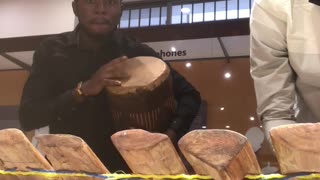Vietnamese traditional toy: To He
Vietnamese traditional toy: To He
These simple toys still give children immense joy during the Mid-Autumn season.
The recipe for success in making it lies in the preparation of the dough. The craftsman first grinds rice into fine powder, then pours water into the powder and mixes it until he achieves a sticky lump. He places the lump in a pot of water, brings the water to a boil, and cooks the paste for an hour. When the lump rises to the water’s surface, dips, and rises again, the craftsman removes it from the pot. Then he applies seven colours: white. black, green, yellow, violet, pink, and red. Miraculously, the different colours never stain one another when he assembles the parts of a to lie figurine.
Many generations of Vietnamese children have been overjoyed when their mothers return from market with a To he. Children can even eat to he after playing with them. Each craftsman embarking on the to he trade learns to humour customers, especially children. The lesson of humanity is the first bears in mind. “If we love people, they will surely come to us,” to he makers say.
Making To he doesn’t bring much profit. The materials rice paste, bamboo-stick holders, colourings – are inexpensive and locally available. A craftsman only charges customers for his patience and care. A To he in a rural market costs between VND 500 and VND 1.000 (US$.03 -$.07). Makers who travel farther field to the larger cities can sell a To he for between VND 2.000 to VND 3.000 (US$.13 – $.20).
Customers can place their orders, watch the craftsman mould the toy, and be pleased with the results in minutes. A To he can depict a person, a famous general, a folk-tale character, an animal, or a flower. The makers remember the characteristics of every subject. They are experts in using exactly the right amount of paste to form each separate part of each kind of toy as if these skills were an inborn talent.
-
 1:08
1:08
MRDUONG
3 years agohow to take care of yourself dog's
3122 -
 0:29
0:29
Kiabs
2 years agotraditional instrument
44 -
 LIVE
LIVE
Kaloopy - The Eye Candy Channel
15 hours agoKaloopy - Eye Candy - Episode 3
3,444 watching -
 3:28:39
3:28:39
Akademiks
6 hours agoDRAKE FIRES on Kendrick Lamar ! HOLLY ! BLOCK IS BEING SPUNN!!!!!
80.8K53 -
 1:44:46
1:44:46
Fresh and Fit
7 hours agoCRAZY Frank Castle On Disrespectful UNGRATEFUL Girl!w/ SNEAKO & SonnyFaz
137K232 -
 2:00:17
2:00:17
SNEAKO
10 hours agoSNEAKO X LAUREN CHEN
84.9K54 -
 1:12:09
1:12:09
Talk Nerdy 2 Us
8 hours ago🚨Cyber Siege: From White House Scandals to Global Cyber Threats 🚨
46.2K16 -
 26:49
26:49
Alexis Wilkins
15 hours agoBetween the Headlines with Alexis Wilkins: Michael Cohen on Tik Tok, Free Speech, AR Lectern, FDNY
49.9K33 -
 1:53:34
1:53:34
Fresh and Fit
1 day agoSulaiman Ahmed And Destiny Debate Israel Palestine Conflict!
187K357 -
 1:35:13
1:35:13
Roseanne Barr
13 hours ago $12.26 earnedGuns And Chardonnay | The Roseanne Barr Podcast #46
78.2K135